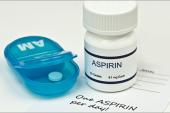MASTER DAPT: One Month's Enough in Patients at High Bleeding Risk
In an all-comers HBR group, 1-month DAPT was noninferior to 3 months or longer, at least with the bioresorbable stent used here.

(UPDATED) MASTER DAPT, the latest and largest randomized clinical trial to tackle the conundrum of dual antiplatelet therapy (DAPT) duration in post-PCI patients at high risk for bleeding, indicates that 1 month is noninferior to 3 months or more, while also cutting the risk of bleeds.
In high-bleeding-risk (HBR) patients implanted with a biodegradable-polymer, sirolimus-eluting stent, those randomized to discontinue DAPT 1-month post-PCI had roughly similar rates of both net adverse clinical events (NACE) and major adverse cardiac or cerebrovascular events (MACCE) as patients randomized to standard therapy (at least 2 months of additional DAPT), meeting the trial definition for noninferiority.
Since both of those noninferiority criteria were met, investigators preceded with an analysis of major and clinically relevant nonmajor bleeding. Here, the abbreviated DAPT strategy proved superior to the standard approach.
Marco Valgimigli, MD, PhD (Cardiocentro Ticino Foundation, Lugano, Switzerland), presented the results during a Hot Line session Saturday at the European Society of Cardiology (ESC) Congress 2021. They were published simultaneously in the New England Journal of Medicine.
Two other major trials, GLOBAL LEADERS and STOPDAPT2, have addressed strategies of shorter DAPT duration. MASTER DAPT differs in that it specifically enrolled patients at high risk for bleeding, including more than one-third who were taking an oral anticoagulant, but without restricting enrollment based on ischemic presentation. Moreover, patients were randomized only if they were clear of ischemic or active bleeding events at the time of screening, which was 30 to 44 days after their procedures.
“This is a highly selected population in whom the bleeding risk is high, and in that space, this is an all-comers HBR population,” Valgimigli clarified during a media briefing. “We have already seen from prior studies that if you are HBR you don't derive ischemic benefit by prolonged DAPT, you only derive bleeding risks; however, that has never been prospectively tested. MASTER DAPT is the first prospective study, randomizing [patients] to stop or continue DAPT in excess of 1 month, in which we have no selection criteria based on ischemic risk.”
MASTER DAPT
MASTER DAPT randomized 4,434 patients to either abbreviated or standard therapy, then tracked outcomes for 335 days. In all, 7.5% of patients in the abbreviated-therapy group and 7.7% of the standard-therapy group had a NACE (death from any cause, myocardial infarction, stroke, or major bleeding), and 6.1% and 5.9%, respectively, had a MACCE (all-cause death, MI, or stroke), meeting the noninferiority definitions.
Major or clinically relevant nonmajor bleeding, which was the third, ranked primary outcome, occurred in 6.5% of the abbreviated-therapy patients and in 9.4% of standard-therapy group, a 2.82-percentage-point difference that met criteria for superiority (95% CI -4.40 to -1.24; P < 0.001).
“One month of dual antiplatelet therapy was noninferior to treatment continuation for at least 2 additional months for the occurrence of net and major adverse clinical events, and [it] reduced major or clinically relevant nonmajor bleeding,” Valgimigli summarized.
Important Details
Valgimigli clarified to TCTMD that clopidogrel monotherapy—not aspirin and not a newer, more-potent agent—was the antiplatelet of choice for the majority of physicians following DAPT discontinuation. “The clinicians were simply recruiting truly HBR patients in whom giving a potent P2Y12 inhibitor, even as a monotherapy, is probably posing safety concerns. And that is why clopidogrel is actually dominating the picture here, even in ACS patients,” he said.
Additional analyses will address whether results differed with antiplatelet therapy choice, as well as according to ACS or stable CAD presentation, and they will also look at patients who were and were not taking oral anticoagulation (OAC).
“The study prespecified two different DAPT durations in the control group for patient with and without oral anticoagulation, which is very important,” Valgimigli told the press. “In patients with OAC, the protocol said at least an additional 2 months of DAPT, whereas in patients without OAC, [it specified] at least an additional 5 months of DAPT.” Co-primary investigator Pieter Smits, MD, PhD (Maasstad Hospital, Rotterdam, the Netherlands), will be presenting the OAC analysis from MASTER DAPT elsewhere at ESC, he noted.
Press conference moderator Carlos Aguiar, MD (Centro Hospitalar de Lisboa, Lisbon, Portugal), stressed to TCTMD that this OAC analysis will be particularly important, because having a concomitant OAC on board is likely “doing something” beneficial. “It’s certainly a strong reason and a rather safe reason to shorten the duration of DAPT,” he said.
As a note of caution, Valgimigli pointed out that the trial results are specific to the bioresorbable polymer stent used in the study, the Ultimaster (Terumo), but said they speak to the impact new stent designs have had and will continue to have on DAPT duration.
Kurt Huber, MD (Sigmund Freud University Medical School, Vienna, Austria), a press conference discussant, homed in on the importance of stent design. “My main question for the future is: these were HBR patients, but should we rethink our strategy in all our patients?” asked Huber. “Eventually, in the future,” he predicted, “we will not see 12 months of recommended DAPT in many of our patients, based on the fact that we now have stents with very fast reendothelization, and maybe 1 to 3 months will be, in all patients, enough.”
Aguiar reminded TCTMD that current guidelines give a level of evidence C (expert opinion) for shortening DAPT duration in HBR patients. He anticipates upcoming guidelines will take MASTER DAPT into account.
“We will see a change, because this trial specifically addresses these people at considerably high risk of bleeding [and has] the largest number of oral anticoagulated patients, with a formal indication for OAC,” he predicted.
Furthermore, this trial did not select patients based on coronary anatomy,” Aguiar continued. “So those more dangerous coronary anatomies where the risk of stent thrombosis is very concerning, these patients were also included in this trial and also those with acute coronary syndromes were in the trial, so patients where you would feel rather uncomfortable going for 1 month and you would rather do 3 to 6 months” of DAPT, as current guidelines specify. “I think we can [expect to] see, on the one hand, a change in the level of evidence [for HBR patients] and on the other we will probably see an even shorter duration for the ACS guidelines, where it’s 3 to 6 months DAPT,” he said. “Maybe that can be pushed back to 1 month.”
Like Valgimigli, however, Aguiar believes that recommendation, for now, can only be applied to this specific stent design.
Hot Line Reaction
Response by the moderators and panelists following Valgimigli’s Hot Line presentation were largely positive, with Roxana Mehran, MD (Icahn School of Medicine at Mount Sinai, New York, NY), calling the trial a “game changer” and Jean-Philippe Collet MD, PhD (Sorbonne University, Pitie Salpetriere Hospital, Paris, France), calling it a “great trial.”
Davide Capodanno MD, PhD (University of Catania, Italy), the designated discussant, offered a deep dive into the numbers concluding that, for both the NACE and MACE endpoints, the noninferiority findings were “statistically robust.”
“And this is important,” he said, “because I think these are the two most important endpoints of this trial: we need some reassurance that an abbreviated DAPT regimen doesn't have any penalty.”
Capodanno predicted that the findings will reassure clinicians in practice and will also be incorporated in future guidelines, although the precise phrasing of the recommendations will be tricky, he said, given the lack of an upper limit for DAPT duration in the trial’s control arm as well as the longer than currently recommended duration of triple therapy among the OAC patients.
Unanswered questions, Capodanno said, are whether these findings can be extrapolated to other new-generation stents and how different monotherapy regimens would compare.
Panelist Robert A. Byrne, MB BCh, PhD (Mater Private Hospital, Dublin, Ireland), also praised Valgimigli for what he called an “important clinical trial.”
“There's been a very large number of trials of antithrombotic therapy after PCI in recent years, and all of them have made an important contribution. But I think this is a standout trial for a couple of reasons,” Byrne said. “We have become more comfortable with using abbreviated DAPT in high-bleeding-risk patients who undergo PCI and that's based to a large extent on stent trials—LEADERS FREE to name one, SENIOR to name another—that have given us confidence, But definitive or more robust evidence was lacking, until now.
Noting that investigators saw “absolutely no signal” of an uptick in ischemic complications with the abbreviated DAPT regimen and that the bleeding rates were “in line with expectations,” Byrne noted that the most serious type of bleeding (BARC 3-5) was not significantly reduced. “Were you surprised not to see a stronger effect in terms of BARC 3-5?”
“You are completely right,” Valgimigli replied, saying they were expecting a reduction in more serious bleeds based on prior trials. The explanation might be that the “standard” DAPT comparator was actually shorter than what has typically been used in single-arm studies with historical controls, he said. “We were comparing 1-month DAPT with a relatively short duration. Even if we called it ‘standard DAPT,’ it was actually at least the 6 months in the non-OAC patient and at least 3 months in OAC patients, and I think that could perhaps explain why the BARC 3 bleeding was not significantly reduced per se.”
Having said that, he noted, most of the BARC 2 events in this trial were actually occurring outside of hospital, so they were “actionable” and “nontrivial” bleeding events.
In a somber moment before launching into the MASTER DAPT findings, Valgimigli dedicated his presentation to those who have died or will die in the COVID-19 pandemic.
Shelley Wood was the Editor-in-Chief of TCTMD and the Editorial Director at the Cardiovascular Research Foundation (CRF) from October 2015…
Read Full BioSources
Valgimigli M, Frigoli E, Heg D, et al. Dual antiplatelet therapy after PCI in patients at high bleeding risk. New Engl J Med. 2021;Epub ahead of print.
Disclosures
- Valgimigli reports research contracts with Terumo, the study sponsor, as well as consulting and speakers fees with Terumo, Biotronik, Abbott, Alvimedica, AstraZeneca, and Idorisa.
- Huber reports lecturing and consulting for Amgen, AstraZeneca, Bayer, Boehringer-Ingelheim, Bristol-Myers Squibb, Daiichi Sankyo, Eli Lilly, Novartis, Pfizer, and Sanofi Aventis.
- Aguiar reports having no conflicts of interest.





Comments